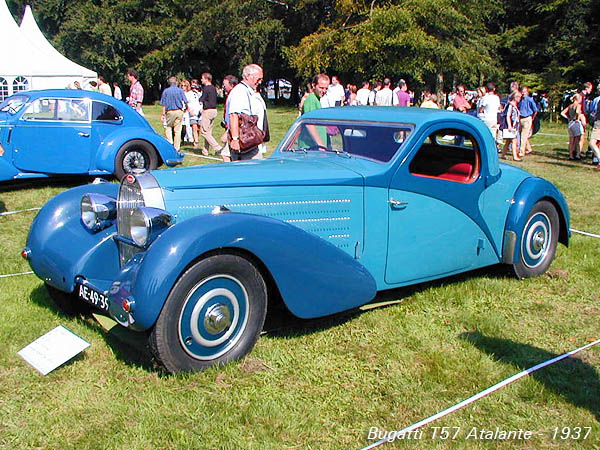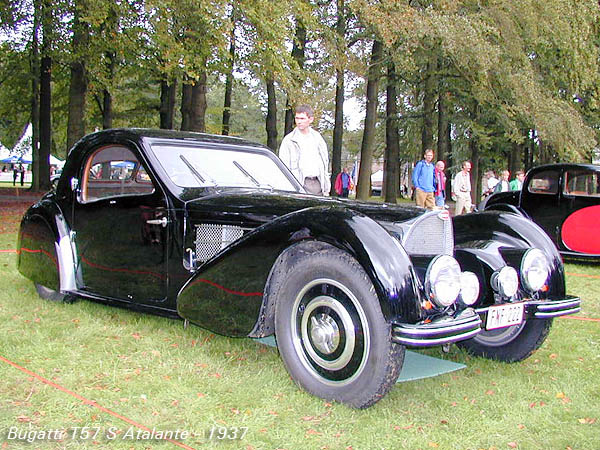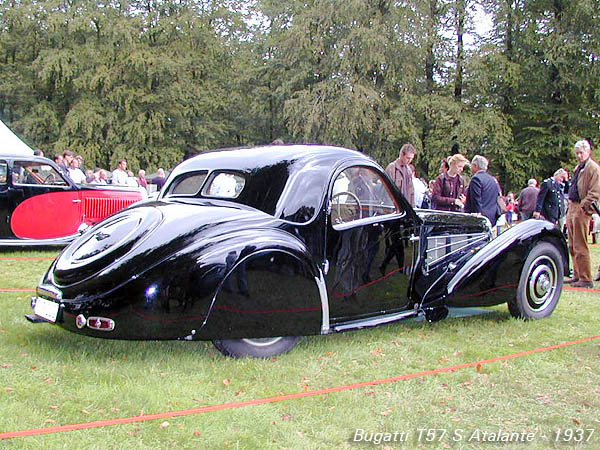It didn't bear any reference to the Alps, but "Atalante" was a wonderfully fitting mythological name for the 2-seater coupe models of the Type 57. It was presented in 1935, one year after the introduction of the Type 57 and from 1936 it was available on both the standard and the low versions of the chassis. The Atalante was fitted with some of the most elegant and extravagant bodies from that era. Low slung and stretched, with voluptuous curves and often expressive paint jobs it represented artistry in true form, cars which could be enjoyed as much from the outside as by the driver inside.
 The factory body on the standard chassis, as seen on this picture, showed the hand of Ettore Bugatti's son Jean. He introduced sculpted and streamlined forms to the Bugatti design vocabulary with models like the Type 41 Royale "Esders" roadster and the Type 55 Super Sport. The Atalante body continued and improved on that, resulting in some of the most coveted cars from the pre-WW2 period. The factory body on the standard chassis, as seen on this picture, showed the hand of Ettore Bugatti's son Jean. He introduced sculpted and streamlined forms to the Bugatti design vocabulary with models like the Type 41 Royale "Esders" roadster and the Type 55 Super Sport. The Atalante body continued and improved on that, resulting in some of the most coveted cars from the pre-WW2 period.
The "standard" Atalante 2-door, 2-seater coupe body style had a roll-back top as an option Though it's disputed, it appears that there also was an Atalante cabriolet version available. The standard chassis was remarkably long for a 2-seater, which made the bonnet look almost endless compared to the low and compact passengers compartment. All Type 57 standard chassis featured the typical flat "horseshoe" Bugatti radiators.
 The Atalante models on the low chassis were dubbed "Surbaissé" (which translates to "lowered") and received an S with the Type 57 designation. They were priced about 30% above the already very expensive standard Atalante and saw a very limited production as a result. From 1936 to 1938, when the S chassis was taken out of production, about 40 Atalantes with the S specifications left the factory. The Atalante models on the low chassis were dubbed "Surbaissé" (which translates to "lowered") and received an S with the Type 57 designation. They were priced about 30% above the already very expensive standard Atalante and saw a very limited production as a result. From 1936 to 1938, when the S chassis was taken out of production, about 40 Atalantes with the S specifications left the factory.
This is a pity because the low chassis Atalante was even more beautiful than the standard model. Thanks to a 32 cm reduction in wheelbase, a lower ride height because the rear axle ran through the chassis frame instead of underneath, a lower bonnet because of a dry-sump lubrication system (no oil pan) and the different V-ed radiator shell it was better proportioned and looked more aggressive, as you can see here.
Apart from the dry-sump lubrication system and the shorter and lower chassis, the S specification included a higher engine compression, a 2-plate clutch and a Scintilla Vertex ignition (instead of coil ignition).
 As standard the Atalante was powered by the straight 8-cylinder, 3257 cc engine shared by all Type 57 models. It produced about 135 hp @ 5000 rpm, enough for a maximum speed of around 160 kph and a 0 to 100 kph acceleration in 12.2 seconds. A compressor could be installed as an option (usually referred to as the Type 57 C), increasing the power output to 160 hp @ 5000 rpm and the maximum speed to about 180 kph. And then it gets interesting: the lighter S chassis with the tuned version of the Type 57 engine was good for 175 hp @ 5500 rpm and 190 kph. This engine could also be fitted with a compressor, making it a Type 57 SC, and this supercharged version made 210 hp @ 5500 rpm and 200 kph possible. Think about it: this was more than twice as much as a regular saloon car at that time was capable of, so this was a true supercar. As standard the Atalante was powered by the straight 8-cylinder, 3257 cc engine shared by all Type 57 models. It produced about 135 hp @ 5000 rpm, enough for a maximum speed of around 160 kph and a 0 to 100 kph acceleration in 12.2 seconds. A compressor could be installed as an option (usually referred to as the Type 57 C), increasing the power output to 160 hp @ 5000 rpm and the maximum speed to about 180 kph. And then it gets interesting: the lighter S chassis with the tuned version of the Type 57 engine was good for 175 hp @ 5500 rpm and 190 kph. This engine could also be fitted with a compressor, making it a Type 57 SC, and this supercharged version made 210 hp @ 5500 rpm and 200 kph possible. Think about it: this was more than twice as much as a regular saloon car at that time was capable of, so this was a true supercar.
Still, despite its good looks and its agility the Atalante wasn't much of a commercial success and so it disappeared from the Bugatti catalogue in 1938. It probably was too expensive, extreme and unpractical.
|
